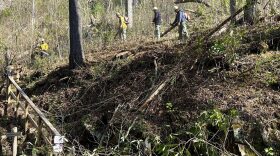The scariest thing in yards this Halloween may not be trick-or-treaters, but "zombie trees."
These trees aren't dead, but they are damaged in ways that can kill the tree, or cause its decline. Arborist Matt Betz, the assistant district manager of the Davey Tree Expert Company in Charlotte, said the term can describe trees with issues ranging from limb damage to internal rot.
“A lot of times you can have trees, they've gotten twisted around in hurricanes, or they have stress cracks or large dead limbs up in the canopy,” Betz said. “They don't look like they're an issue until something happens. They're extremely hazardous trees, but to the layman, you don't know that they're hazardous.”

According to the U.S. Forest Service, zombie trees can fall unexpectedly on personal property and cause serious injuries. Betz said that as an arborist, he deals with zombie trees weekly.
In North Carolina specifically, Betz said it’s common for people to notice zombie trees in the months following a hurricane, since hurricane winds can cause the wood fibers in a tree to splinter.
Hazardous tree damage isn't always noticeable, so Betz encouraged homeowners to pay attention to split, cracked, and dead limbs. He said sometimes the only signs of zombie trees are large mushrooms growing at the base of a tree, which indicate rot.
“If you've got decay at the base of the tree, the tree needs to come down,” Betz said. “That's the foundation of the tree, just like the foundation of a home. If you've got termite damage and decay, it's like, ‘Hey, something's gonna give at some point.’ So, we either need to deal with it soon, or potentially suffer the consequences if it's ignored because it's not going to get any better.”
Betz said that if zombie trees are identified in time, arborists can remove the trees, or potentially even save them.







